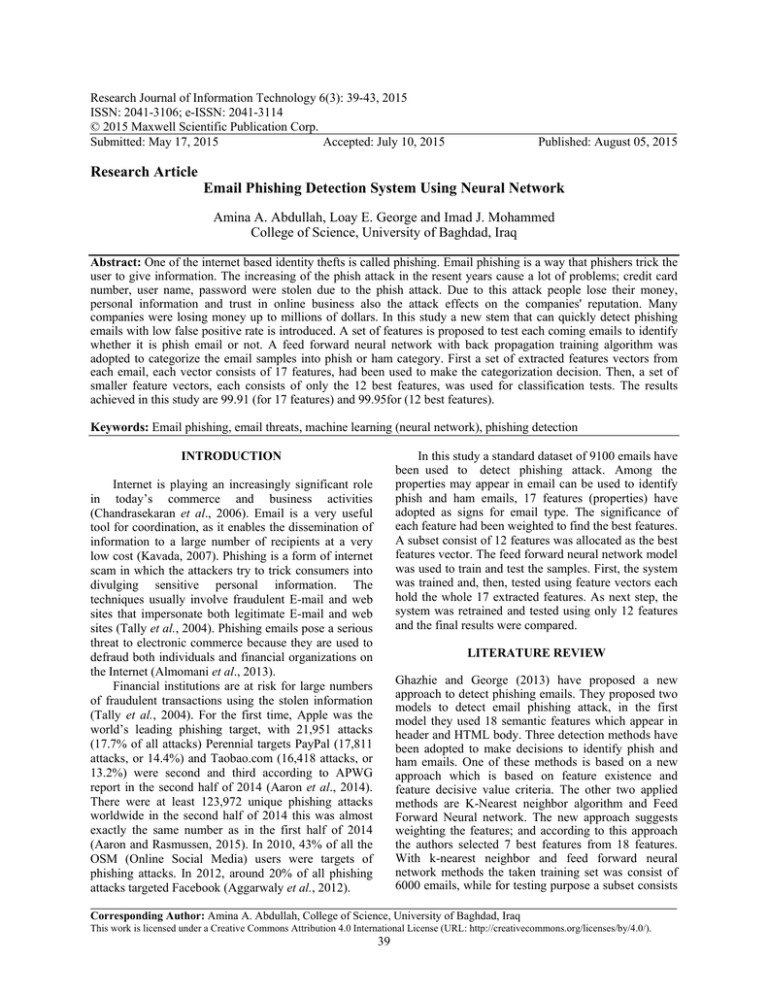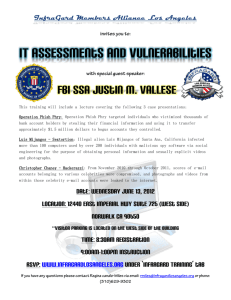Research Journal of Information Technology 6(3): 39-43, 2015
advertisement

Research Journal of Information Technology 6(3): 39-43, 2015
ISSN: 2041-3106; e-ISSN: 2041-3114
© 2015 Maxwell Scientific Publication Corp.
Submitted: May 17, 2015
Accepted: July 10, 2015
Research Article
Published: August 05, 2015
Email Phishing Detection System Using Neural Network
Amina A. Abdullah, Loay E. George and Imad J. Mohammed
College of Science, University of Baghdad, Iraq
Abstract: One of the internet based identity thefts is called phishing. Email phishing is a way that phishers trick the
user to give information. The increasing of the phish attack in the resent years cause a lot of problems; credit card
number, user name, password were stolen due to the phish attack. Due to this attack people lose their money,
personal information and trust in online business also the attack effects on the companies' reputation. Many
companies were losing money up to millions of dollars. In this study a new stem that can quickly detect phishing
emails with low false positive rate is introduced. A set of features is proposed to test each coming emails to identify
whether it is phish email or not. A feed forward neural network with back propagation training algorithm was
adopted to categorize the email samples into phish or ham category. First a set of extracted features vectors from
each email, each vector consists of 17 features, had been used to make the categorization decision. Then, a set of
smaller feature vectors, each consists of only the 12 best features, was used for classification tests. The results
achieved in this study are 99.91 (for 17 features) and 99.95for (12 best features).
Keywords: Email phishing, email threats, machine learning (neural network), phishing detection
In this study a standard dataset of 9100 emails have
been used to detect phishing attack. Among the
properties may appear in email can be used to identify
phish and ham emails, 17 features (properties) have
adopted as signs for email type. The significance of
each feature had been weighted to find the best features.
A subset consist of 12 features was allocated as the best
features vector. The feed forward neural network model
was used to train and test the samples. First, the system
was trained and, then, tested using feature vectors each
hold the whole 17 extracted features. As next step, the
system was retrained and tested using only 12 features
and the final results were compared.
INTRODUCTION
Internet is playing an increasingly significant role
in today’s commerce and business activities
(Chandrasekaran et al., 2006). Email is a very useful
tool for coordination, as it enables the dissemination of
information to a large number of recipients at a very
low cost (Kavada, 2007). Phishing is a form of internet
scam in which the attackers try to trick consumers into
divulging sensitive personal information. The
techniques usually involve fraudulent E-mail and web
sites that impersonate both legitimate E-mail and web
sites (Tally et al., 2004). Phishing emails pose a serious
threat to electronic commerce because they are used to
defraud both individuals and financial organizations on
the Internet (Almomani et al., 2013).
Financial institutions are at risk for large numbers
of fraudulent transactions using the stolen information
(Tally et al., 2004). For the first time, Apple was the
world’s leading phishing target, with 21,951 attacks
(17.7% of all attacks) Perennial targets PayPal (17,811
attacks, or 14.4%) and Taobao.com (16,418 attacks, or
13.2%) were second and third according to APWG
report in the second half of 2014 (Aaron et al., 2014).
There were at least 123,972 unique phishing attacks
worldwide in the second half of 2014 this was almost
exactly the same number as in the first half of 2014
(Aaron and Rasmussen, 2015). In 2010, 43% of all the
OSM (Online Social Media) users were targets of
phishing attacks. In 2012, around 20% of all phishing
attacks targeted Facebook (Aggarwaly et al., 2012).
LITERATURE REVIEW
Ghazhie and George (2013) have proposed a new
approach to detect phishing emails. They proposed two
models to detect email phishing attack, in the first
model they used 18 semantic features which appear in
header and HTML body. Three detection methods have
been adopted to make decisions to identify phish and
ham emails. One of these methods is based on a new
approach which is based on feature existence and
feature decisive value criteria. The other two applied
methods are K-Nearest neighbor algorithm and Feed
Forward Neural network. The new approach suggests
weighting the features; and according to this approach
the authors selected 7 best features from 18 features.
With k-nearest neighbor and feed forward neural
network methods the taken training set was consist of
6000 emails, while for testing purpose a subset consists
Corresponding Author: Amina A. Abdullah, College of Science, University of Baghdad, Iraq
This work is licensed under a Creative Commons Attribution 4.0 International License (URL: http://creativecommons.org/licenses/by/4.0/).
39
Res. J. Inform. Technol., 6(3): 39-43, 2015
of 3100 emails was used. In their second suggested
model (Ghazhie and George, 2013) they suggested
using a set of 45 significant words which may appear in
the text body of the email. Two categorization methods
have been used; they are:
was 6 subsets: 3 subsets with LUA feature and 3
subsets without LUA feature. They used 90% of data to
train the system with random forest and 10% to test the
system while they used 30% of data to train the system
with LUA and 70% to test the system. The result they
got is 99.45% with low false positive rate.
Vaishnaw and Tandan (2015) proposed a hybrid
system to detect phishing email. They used 47 features
and 8266 emails to detect. They used many machine
learning algorithms: Bayesian, CART (classification
and regression technique, CHAID (Chi-Squared
Automation Interaction Detection), ANN (Artificial
Neural Network), SVM (support vector machine),
decision tree, C5.0 and QUEST. They used bagging and
boosting technique to combine the models. First they
trained and tested each model alone to find the result of
each model, then they used a combination of the two or
more models, they depend on the accuracy result that
they got to choose the best system. They combined
Bayesian net model with the other models to get good
results. They refereed that their best achieved result is
99.32% when the combination of CART and Bayesian
is used.
Fette et al. (2007) proposed a new method to detect
phishing emails called PILFER. They used phish data
set contains 860 emails and ham data set contains 6950
emails. They used 10 features in their system. They
referred the method result is 99% and their methods is
better than SpamAssassin. Also, the achieved rate of
false positive is 0.1%.
Word existence and word decisive value criteria
k-nearest neighbor. They used their new method to
weight the word and they found best 11 words.
They trained the neural network with 6000 emails
and they used 3100 emails to test the model. They
used two data sets, ham data set and phish data set
each data set contains 4550 emails. They claimed
that the best result they got using k-nearest
neighbor achieved 98.92% with features best
model and 91.99% with word best model.
Khonji et al. (2012) proposed an enhancement to
LUA (Lexical URL Analysis) which was created by
them in previous study (Khonji et al., 2011). The study
claims an enhancement for anti-phishing email filtering
is accomplished. The suggested method uses random
forest machine learning with LUA. The method is used
to detect phish website pages and phish emails. They
collected a data set of website of total 25428 legitimate
URLs and 48305 phish URLs from Khalifa university's
HTTP proxy and volunteers whom used their
experimental HTTP proxy server, the email data set is
4116 phish emails and 4150 ham emails. For website
classification they used LUA tokenization mechanism.
The best result they got is 97.31%. In the email
classification model they used features that were
extracted from email and they added the LUA as a
feature, where the highest value of LUA represents as
phish value. They used two sets of features; the first set
is without LUA feature, it contains 47 features. While
the second set contains the same features of first set
with the LUA feature. They used a wrapper and bestfirst as the feature subset selection method, the result
METHODOLOGY
Two data sets have been used in this study, phish
data set and ham data set, each data set contains 4550
emails. In this study, a set 17 features that commonly
appeared in phish emails have been used in the phishing
Table 1: The features used for phish email detection
Feature no.
Description
1
If text/html in the content type of email, the feature takes 1 otherwise it is 0
2
If from part of email header equal to the reply-to part this feature takes the value 1 otherwise 0
3
If <form in the html body of email this feature set to 1 otherwise it take the value 0
4
If <script> or <javascript> tag in the html code in html body the feature takes value 1 otherwise it take the value 0
5
If URL in the html body is more than 3 this feature takes value 1 otherwise 0
6
If from part in email header is not equal to any of domains in URL this feature is set to 1 otherwise 0
7
This feature is 1 if the dot in the domain of any links in the html body is more than 3 otherwise it is 0
8
If the number of pictures is used as links is more than 2 this feature is set to 1 otherwise it is 0
9
If the domain in URL is more than 3 this feature takes 1 otherwise it is set to 0
10
If the symbol '@' is in the URL this feature takes the value 1 otherwise it takes 0
11
If the ports that used as link in URL is not in list of legal port; this feature takes the value 1 otherwise it takes the value 0. List of
legal ports {':80', ':80/', ':443', ':443/'}
12
If hexadecimal characters are used in URL this feature takes the value 1 otherwise 0
13
If the IP based URL is used the feature takes the value 1 otherwise 0
14
The value 1 is taken if one of the words: 'click', 'click here', 'log' and 'login' are appeared in text URL. Otherwise the feature
takes the value 0.
15
This feature takes the value 1 if the text URL is not matched with the target URL otherwise the feature takes the value 0
16
The value 1 is taken if the attacker attempts to use fake secure socket layer (SSL) in the text URL to trick the user. In this case
the 'https' appear in text URL while the target URL is 'http'. Otherwise the feature takes 0.
17
If the size of email is less than 25 KB the feature takes the value 1 otherwise the feature takes the value 0.
40 Res. J. Inform. Technol., 6(3): 39-43, 2015
detection system; Table 1 shows the 17 features and a
short description for each feature. These features are
extracted from emails and the best features are founded
using fist order statistical measures. Artificial feed
forward neural network with back propagation
algorithm is used to train and then identify phish and
ham emails. The system was trained and tested twice;
first using all the 17 extracted features and then using
the best features. The system passed through two
phases; the first phase is training using back
propagation algorithm and the second phase is phish
emails detection.
Preprocess phase: Email consists of header and body.
The features are extracted from the email header fields
("From", "Reply-to", "Content-type") and from HTML
body. The pre-processing phase consists of two main
steps:
Feature extraction: 17 features have been extracted
for each email. For each data set a two dimensional
array consists of 4550 row (number of emails) and 17
column (number of features) was used to store the
features (i.e., one vector for each email). The array of
features contains only 1s' and 0s'. The value 1 was used
to indicate the feature existence and the value 0 to
indicate that the feature is not existed.
Select best features: The occurrence of each feature in
the phish and ham emails is different. The selection of
each feature depends on two basic factors: The
frequency of occurrence of the feature in phish and ham
emails, the difference between the phish and ham
preparation. The following steps were used to find the
best features:
o
Calculate the number of occurrence of each feature
in both ham and phish emails, the calculated
occurrence frequencies of all features belong to
certain phish or ham email file are saved in a
vector.
Calculate the probability (p) of occurrence of each
feature in ham and phish emails, separately using
the following equation:
o
o
o
%100
%100
where, pphish(i) is the probability of ith feature in
phishing emails, pham(i) is the corresponding
probability in ham emails; iϵ[1,17]. The values of
pphish() and pham() are stored in phish or ham
vectors, respectively.
Find the highest probability of each feature for the
ham and phish emails; and they are compared. If
the probability of feature occurrence in phish
emails is much higher than its probability in ham
emails; this means that the feature is a good
discriminating feature. If the percentage in phish is
equal or less than the percentage in ham feature,
the feature will be registered in features discard
list.
Calculate the relative difference between ham and
phish probabilities: If the feature in the previous
step was not added to discard list then the
difference is calculated; simply it is a subtraction
of probability occurrence in ham emails from the
its corresponding probability in phish emails. If the
calculated relative difference is high, the feature
will be considered a good feature, otherwise the
feature is added to discard list.
Remove unwanted features: The last step is to
delete all the discarded features. The good features
that remained are 12 features.
Select train and test vectors: This step is done for
both cases of vectors (with 17 features and with 12
best features features). A statistical analysis was
conducted on the established features vectors and it
found that most of the features appear more than
once and their repetition numbers are different. The
following steps are taken to remove the redundancy
and select a reduced set of non-redundant templates
of feature vectors:
The first feature vector in the phish array is added
to the unduplicated array; then each vector in phish
array is compared with all vectors in the
unduplicated array, if the tested vector does not
exist then the feature vector is added to the
unduplicated array. Same procedure is done with
ham array.
Extract the common vectors: Extract the vectors
that appears in both arrays (unduplicated ham and
phish), these vectors is added to the array of
common vectors.
Count the occurrence of the common vectors:
The occurrence of each common vector in phish
array is calculated. Same steps are done for ham
array.
If the common vector appears in ham array less
than it appears in phish array, then the vector will
be discarded from the ham array and unduplicated
ham and vice versa. Also, if the vector appears
equally in both ham and phish, this vector is
removed from both ham and phish arrays and
unduplicated arrays too.
After accomplishing the above steps, then the final
arrays (feature array and unduplicated array of both
ham and phish) have non redundant vectors.
41 Res. J. Inform. Technol., 6(3): 39-43, 2015
Detection phase: This phase is consists of two phases
(i.e., the training and testing phases), the steps of these
phases are:
neural network model was trained and tested using with
different number of data samples data for both features
vectors (with 17 and 12 features).
Training: The array of unduplicated vectors was used
as training, which is fed as input for back propagation
for training the feed forward neural network. The neural
network was trained using different learning rates and
momentums to find their proper values. The proper
weights were found to be between (0.001-0.0001). The
output of training the neural network is a set of weights
that used in the testing phase.
The neural network with 17 features: The system
was trained and tested using 8801 vectors (emails
sample), the train vectors was 587 (66 ham and 521
phish vectors), the test vectors was 8214 vector (4430
ham and 3784 phish). Different learning rate,
momentum and hidden nodes have been investigated to
find the best neural network setting values. The best
learning rate was 0.4 and the momentum was 0.07.
Table 2 shows the detection results for feed forward
neural network has one hidden layer consist of 20 nodes
and trained using with learning rate = 0.4 and
momentum = 0.07.
Testing: In this phase the test set of feature vectors had
been used to identify ham and phish emails.
The neural network with 12 features: The system
was trained and tested using total 8697 vectors (emails
sample), the train data was 282 (21 ham and 261 phish)
vectors, the test data was 8415 (4415 ham and 4000
EXPERIMENTAL RESULTS
The result of the proposed fast detection method
was evaluated using TP, FN, TN, FP and accuracy. The
Table 2: The detection results for the case of using 17 discriminating features
No. of hidden TP
TN
nodes
(%)
(%)
FN (%)
FP (%)
Acc.
1
99.94
90.47
0.05
9.52
95.21
2
99.86
99.72
0.13
0.27
99.80
3
99.86
99.81
0.13
0.18
99.84
4
100
99.81
0
0.18
99.91
5
100
99.81
0
0.18
99.91
6
100
99.81
0
0.18
99.91
7
99.97
99.75
0.02
0.24
99.87
8
99.97
99.75
0.02
0.24
99.87
9
99.97
99.75
0.02
0.24
99.87
10
99.97
99.75
0.02
0.24
99.87
11
99.97
99.75
0.02
0.24
99.87
12
99.97
99.75
0.02
0.24
99.87
13
99.97
99.75
0.02
0.24
99.87
14
99.97
99.75
0.02
0.24
99.87
15
99.97
99.70
0.02
0.29
99.84
16
99.94
90.63
0.05
9.36
95.29
17
99.97
99.75
0.02
0.24
99.87
18
99.94
90.63
0.05
9.36
95.29
19
99.94
90.63
0.05
9.36
95.29
20
99.94
90.63
0.05
9.36
95.29
Training
time (msec.)
0.73
0.50
0.61
0.75
0.82
0.89
0.99
1.12
1.27
1.32
1.55
3.89
1.70
1.84
1.85
2.01
2.11
2.26
2.26
2.47
Testing time
(msec.)
5.41
6.98
8.52
10.55
11.59
12.62
13.46
15.61
17.89
18.45
21.32
22.07
23.48
25.04
26.48
27.51
28.86
31.71
31.99
34.70
Average test time for
one email (msec.)
0.0006
0.0007
0.0009
0.0011
0.0013
0.0014
0.0015
0.0017
0.0020
0.0020
0.0024
0.0025
0.0026
0.0028
0.0030
0.0031
0.0032
0.0036
0.0036
0.0039
Training
time (msec.)
0.79
0.27
0.32
0.36
0.41
0.42
0.48
0.53
0.53
0.63
0.63
0.72
0.72
0.74
0.79
0.90
0.87
0.99
0.99
1.03
Test time
(msec.)
5.08
6.68
7.61
8.69
10.06
11.08
12.50
13.59
14.78
16.46
17.96
18.83
19.59
20.24
22.64
24.44
26.36
27.45
28.47
29.38
Average test time for
one email (msec.)
0.0006
0.0007
0.0009
0.0010
0.0011
0.0013
0.0014
0.0016
0.0017
0.0019
0.0021
0.0022
0.0023
0.0024
0.0026
0.0029
0.0031
0.0032
0.0033
0.0034
Table 3: The detection results for the case of using 12 discriminating features
No. of nodes
1
2
3
4
5
6
7
8
9
10
11
12
13
14
15
16
17
18
19
20
TP (%)
99.65
99.75
100
100
100
100
100
100
100
100
100
100
100
100
100
100
100
100
100
100
TN (%)
96.03
99.90
99.90
5.20
5.20
5.20
5.20
5.20
5.20
5.20
5.20
5.20
5.20
5.20
5.20
5.20
5.20
5.20
5.20
5.20
FN (%)
0.35
0.25
0
0
0
0
0
0
0
0
0
0
0
0
0
0
0
0
0
0
FP (%)
3.96
0.09
0.09
94.79
94.79
94.79
94.79
94.79
94.79
94.79
94.79
94.79
94.79
94.79
94.79
94.79
94.79
94.79
94.79
94.79
Acc.
97.84
99.83
99.95
52.60
52.60
52.60
52.60
52.60
52.60
52.60
52.60
52.60
52.60
52.60
52.60
52.60
52.60
52.60
52.60
52.60
42 Res. J. Inform. Technol., 6(3): 39-43, 2015
phish) vectors. Different learning rate, momentum and
hidden nodes have been used to find the best results to
train the neural network. The best learning rate was
(0.1) and the momentum was (0.01). Table 3 shows the
result for 20 hidden nodes with learning rate = 0.1and
momentum = 0.01.
The time of training and testing the neural network
was, also, calculated for both 17 features and best 12
features.
The results listed in Table 2 shows that the
accuracy was the same with 4, 5 and 6 hidden neurons,
it also shows that as the number of neurons in the
hidden layer increase the time taken to train the neural
increases so the best result was when the number of
hidden nodes is taken 4. The results listed in Table 3
shows that the best accuracy was when 3 hidden
neurons is taken. As the number of nodes increase
above 3 neurons the accuracy drop down to 50%.
Almomani, A., B.B. Gupta, S. Atawneh, A. Meulenberg
and E. Almomani, 2013. A survey of phishing
email filtering techniques. IEEE Commun. Surv.
Tutorials, 15(4): 2070-2090.
Chandrasekaran, M., R. Chinchani and S. Upadhyaya,
2006. PHONEY: Mimicking user response to
detect phishing attacks. Proceedings of the IEEE
International Symposium on a World of Wireless
Mobile and Multimedia Network (WoWMoM),
Buffalo-Niagara Falls, NY, USA, pp: 672-676.
Fette, I., N. Sadeh and A. Tomasic, 2007. Learning
detection phishing emails. Proceedings of the
International World Wide Web Conference
Committee (IW3C2), Banff, Alberta, Canada, pp:
649-656.
Ghazhie, N. and L.E. George, 2013. Methodologies to
Detect Phishing Emails. Published by Scholars'
Press.
Retrieved
from:
http://dl.acm.org/
citation.cfm?id=2613502.
Kavada, A., 2007. The European Social Forum and the
Internet: A Case Study of Communication
Networks and Collective Action. PHD Thesis,
University of Westminster, London, United
Kingdom.
Khonji, M., Y. Iraqi and A. Jones, 2011. Lexical URL
analysis for discriminating phishing and legitimate
e-mail messages. Proceedings of the IEEE 6th
International Conference Internet Technology and
Secured Transactions (ICITST), Abu Dhabi,
United Arab Emirates, pp: 422-427.
Khonji, M., Y. Iraqi and A. Jones, 2012. Enhancing
phishing e-mail classifiers: A lexical URL analysis
approach. Int. J. Inform. Secur. Res., 2(1/2):
236-245.
Tally, G., R. Thomas and T.V. Vleck, 2004. AntiPhishing: Best Practices for Institutions and
Consumers. White Paper, McAfee Inc.
Vaishnaw, N. and S.R. Tandan, 2015. Development of
anti-phishing model for classification of phishing
e-mail. IEEE Int. J. Adv. Res. Comp. Commun.
Eng., 4(6): 39-45.
CONCLUSION
The proposed method of training based on neural
network had achieved very low FN and low FP for both
cases (i.e., using 17 features or only the best 12
features). The extraction of only the best features
caused time drop in testing single email to be 0.81%
and the number of neurons (nodes) in the hidden layer
to be 3 nodes only which is then the required number in
case of using 17 features. The best achieved
classification result (when using 12 features) was
99.95%.
REFERENCES
Aaron, G., R. Rasmussen and A. Routt, 2014. Global
Phishing Survey: Trends and Domain Name Use in
1H2014. Anti Phishing Working Group (APWG),
Lexington.
Aaron, G. and R. Rasmussen, 2015. Global Phishing
Survey: Trends and Domain Name Use in 2H2014.
Anti Phishing Working Group (APWG),
http://www.apwg.org ○ info@apwg.org.
Aggarwaly, A., A. Rajadesingan and P. Kumaraguru,
2012. PhishAri: Automatic Realtime Phishing
Detection on Twitter. Proceedings of the IEEE
eCrime Researchers Summit (eCrime), Las
Croabas, pp: 1-12.
43


